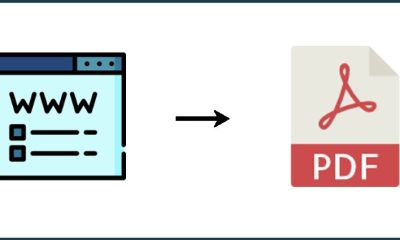Career Tips
Essential Cybersecurity Concepts You Should Know

Effective computer system and network protection is critical for preventing hardware theft and damage, successfully guarding networks and systems, and limiting the danger of data breaches. Cybersecurity specialists do critical work to help firms protect their equipment and data while operating safely. Understanding key cybersecurity ideas can assist technology professionals optimize operations and enhance security efforts.
What is cybersecurity?
Cybersecurity is a practice that businesses use to secure their data, networks, and devices from malicious assaults and digital threats.
Cyberattack prevention, also known as information technology security, is critical because it can help firms protect sensitive data, avoid losses due to system outages, and save money on breach remedies. A strong and comprehensive cybersecurity strategy is critical for businesses, particularly those responsible for protecting sensitive consumer information.
Cybersecurity concepts
1. The confidentiality, integrity and availability (CIA) triad
The three main pillars of cybersecurity are confidentiality, integrity, and availability (CIA). Learning about each of these parts of the discipline can assist organizations and their employees in developing comprehensive protection plans. Many tests and certifications require cybersecurity workers to comprehend these ideas. Here’s a closer look at the three components of the triad:
- Confidentiality: Confidentiality refers to processes organizations take to protect data from unauthorized viewing or use. This can help keep sensitive information secure and safe and improve customer trust.
- Integrity: The second element of the triad, integrity, has to do with maintaining accurate and complete information by protecting it from unauthorized alterations.
- Availability: The last element of the triad, availability, covers data’s accessibility to authorized viewers. This means that those who have the authority to view or change information can do so.
2. Cyberattacks
Another notion that cybersecurity workers must understand is cyberattacks. Learning to defend against various attacks can help businesses plan effective defenses and anticipate dangers. Here’s a breakdown of five of the most popular cyberattack types:
- Malware: Malware is a type of software created to disrupt a system, bypass information authorization requirements, leak information or prevent authorized access attempts. To protect against socially engineered malware, cybersecurity professionals often use anti-malware programs along with end-user education efforts.
- Phishing: Phishing attacks often strive to get login information using spam emails or false information. Two-factor authentication is one method organizations can use to protect against these attacks.
- Social media: Social media often poses many security threats, too. Malignant friend requests or application downloads could carry hacking dangers.
- Persistent: Advanced persistent threats (APT) are enduring and sophisticated attacks that usually rely on phishing or socially engineered malware to work. They can be challenging to anticipate and protect against.
Software patches: Patches, or vulnerabilities, are security lapses that pose opportunities for cyberattacks. Prioritizing patchless software and protection measures can reduce vulnerabilities and reduce unwanted threats.
3. Identify access management (IAM)
IAM is a widely used policy framework for managing online user identities. Access is dependent on specific IT systems. The purpose of IAM is to provide users with the necessary amount of access to perform their system functions properly.
4. Incident response (IR)
A company’s IR protocols are the measures it takes after detecting an incursion. Organizations can reduce the risks associated with attacks, breaches, and incursions by establishing well-defined protocols. It is critical to develop guidelines for each type of threat so that personnel and systems can respond correctly.
5. Security information and event management (SIEM)
SIEM is a critical component for establishing a successful Security Operations Center (SOC). It tries to centralize all security-related log data. To accomplish so, organizations must use software that is interoperable with all of their data sources, allowing for systematic and ongoing analysis.
6. Managed security service provider (MSSP)
An MSSP is a service provider who monitors and maintains consistent security measures. Companies often pay a monthly charge for this service. Endpoint detection software and monitoring firewalls are two types of MSSPs that businesses can use to mitigate attacks.
7. Security operations center (SOC)
Many corporations refer to their security initiatives and divisions as “SOC”. It often involves the organization’s cybersecurity personnel, documented processes, and security technology. Smaller organizations may choose to outsource their security operations, whilst larger companies may have an in-house SOC.
8. Cloud access security brokers (CASB)
CASB refers to the policies that cloud service providers have with their users. Plans frequently contain conventional enforcement processes such as encryption, notifications, and authentication methods. A strong policy can help to build confidence and meet the needs of cloud service users.
9. User and entity behavior analytics (UEBA)
UEBA is a detailed analysis designed to discover user behavior that deviates from typical usage. Comprehensive analytics can assist security teams and software in predicting and comprehending user behavior. Finally, this can reduce log session noise.
10. Indicator of compromise (IOC)
IOCs are network intrusion signals. IOCs can typically be detected during log data analysis because they are triggered by data. IOCs include differences from normal patterns such as geographic abnormalities, unusual outbound site traffic, or unfamiliar activities.
11. Distributed denial of service (DDoS)
Hackers sometimes use DDoS to divert security measures during an attack. It could be a disruption to a web services’ operations or hackers might create multiple IP addresses to flood a site. These efforts can make a web service unusable and especially vulnerable to compromise.
Why is it important for employees to learn concepts of cybersecurity?
There are many reasons it’s important for technology security professionals to understand essential cybersecurity concepts, including:
- Better prepares for attacks
Understanding where attacks originate and how a company intends to address them can help security experts respond to threats more effectively. Being informed of common hacker strategies can also help technology professionals prepare for potential compromises and attacks. Knowing what to expect can help you design more effective defensive techniques.
- Decreases reaction times
Many organizations experience significant service outages as a result of cyberattacks. A business can suffer long-term consequences if it loses client trust, money, or services. Knowing where attacks originate and how they function can help firms cut response times and keep operations running smoothly.
- Ensures employees act as better resources
Finally, security teams with relevant knowledge and information can serve as valuable resources for non-technology professionals. Educating other members of a company on how to detect phishing attacks or malware can help organizations save time and money. If someone is unsure how to handle a suspected attack, they can seek guidance and answers from a cybersecurity professional.












